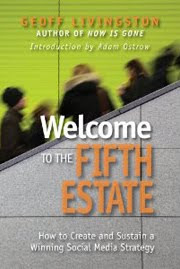 Two people sent me keen observations yesterday: one in a comment, another in an email. The observations are worth sharing. Maybe it will even wake up a few public relations and social media professionals who claim to cover their industry. More and more of them have all but fallen asleep at the wheel.
Two people sent me keen observations yesterday: one in a comment, another in an email. The observations are worth sharing. Maybe it will even wake up a few public relations and social media professionals who claim to cover their industry. More and more of them have all but fallen asleep at the wheel.Motrin is currently embroiled in one of its most pressing public relations challenges and blowing it badly. And yet, nobody in the public relations or social media spheres seem to be covering it. Instead, public relations and social media pros are too busy writing about love me tools, mea culpas about failed panels, and (unbelievably) the 2008 Motrin ad campaign.
Perhaps worse, all the overwriting about the 2008 snarky ad campaign overshadows the current crisis on search engines (unless you are specific).
A Brief About Motrin's New Crisis Communication Battle.
If the snarky ad campaign didn't convince some people that Motrin can be insensitive to consumers, then perhaps the pair of new crisis communication scenarios will make them think twice. The first revolves around 3-year-old Brianna Maya, who was given Motrin in 2000.
ABC reports a "fine rash on her body and mild redness around her eyes morphed into something insidious." The reaction to the medicine, Stevens-Johnson Syndrome and Toxic Epidermal Necrolysis (SJS/Tens), is rare but extremely painful and potentially fatal.
For Maya, it burned and blistered her body inside and out, blinded her in one eye, required her to be sent to a burn unit, and left her reproductive organs destroyed. She also suffered partial brain damage during the acute phase of the reaction.
 According to the new ruling, the SJS/Tens reaction was triggered by Children's Motrin, which is marketed by McNeil Consumer Products, a division of Johnson & Johnson. A jury recently ordered the drug manufacturer to pay $10 million for her injuries after they determined that McNeil Consumer Products, a division of Johnson & Johnson, was negligent in warning consumers about such a risk. Children's Motrin is currently unavailable on the Motrin website.
According to the new ruling, the SJS/Tens reaction was triggered by Children's Motrin, which is marketed by McNeil Consumer Products, a division of Johnson & Johnson. A jury recently ordered the drug manufacturer to pay $10 million for her injuries after they determined that McNeil Consumer Products, a division of Johnson & Johnson, was negligent in warning consumers about such a risk. Children's Motrin is currently unavailable on the Motrin website. Its unavailability comes with the second crisis communication under covered by public relations and social media. It relates to a phantom recall conducted by the company in 2009. The most hideous example of all communication was included in the State of Oregon's complaint. Contractors were advised of the following by the company:
“Do not communicate to store personnel any information about this product. Just purchase all available product. If you are questioned by store personnel, simply advise that you have been asked to perform an audit.”
McNeil Consumer Products and Johnson & Johnson are defending themselves against the lawsuits.
According to The Consumerist, Johnson & Johnson maintains that the labeling was adequate and the condition is "extremely rare" in the Maya case. And other than initially disagreeing with the verdict, most media outlets report Johnson & Johnson is not responding to requests for comment.
As a crisis communication case study, this isn't a quick fix nor can it be cured with the five steps to crisis communication. I started outlining it earlier this week for next, but opted to provide some backgrounder notes after receiving two separate inquiries about PR taking a pass on this one. This fact also makes me amend my review of Welcome To The Fifth Estate from yesterday. It seems more people need to read the book than I initially said.
Rethinking The Fifth Estate With Shrink Wrap.
As mentioned, one of the primary components of Geoff Livingston's book is that communicators must become participants in a larger world to deliver effective communication. And while he doesn't necessarily say it verbatim, therein lies an interesting point for professionals to ponder...
As communicators who claim to be active participants looking out for the greater public, isn't there an unwritten obligation to cover the uncomfortable along with the slapstick sideshows? Or is something else causing PR to be silent about Motrin?
Is it that professional communicators have taken the advice of Shel Holtz to not be a PR ambulance chaser to heart? Is it that most public relations professionals aren't impressed with the numbers this story may or not draw compared to "three steps to develop a social strategy" or some such nonsense? Is it that public relations has moved so far up the 'expert' perception ladder that it has turned in its fluffy bubble for shrink wrap, tightening the plastic until nobody can see anything beyond their own antics?
After all, the two stories mentioned above, combined with the recent discovery that Johnson & Johnson knew its antibiotic Levaquin increased the risk of tendon damage and equally relevant Baby Shampoo debacle, could make Johnson & Johnson the public relations story of the year. And yet, even self-proclained communication leaders at Ragan are more interested in the U.S. Department of Agriculture's food plate.
It's a curious thing, this dramatic shift in content. Over the last year, a field that used to pile on crisis events ad nauseum is now too busy for them. Who knows? It may be that for all the empowerment that came with becoming The Fifth Estate so did the risk of becoming too important to be bothered with the rest of the world.
Johnson & Johnson case study ahead, sometime next week. Of course, I'm sure it won't be more fun than a balloon popping post.




























